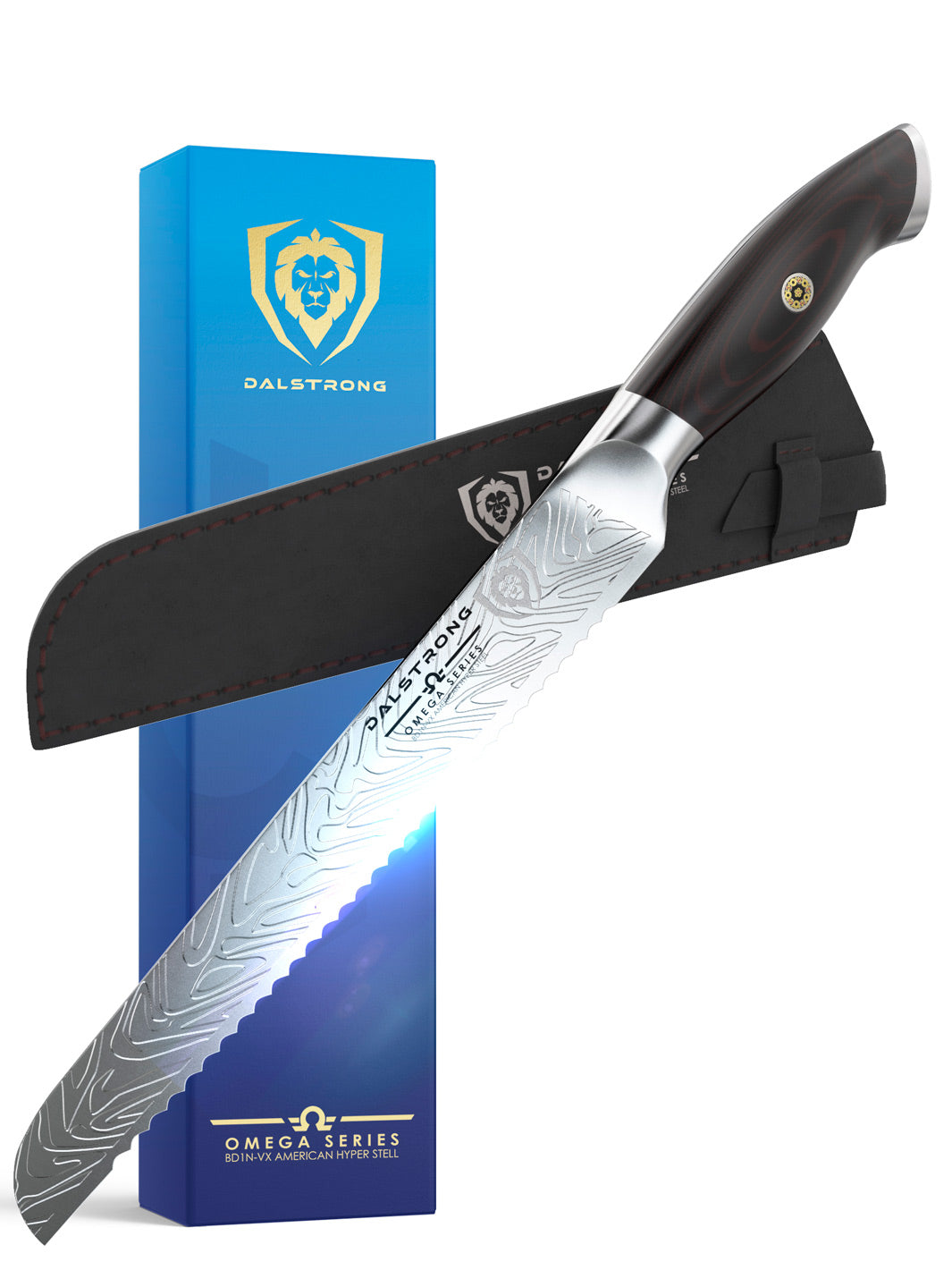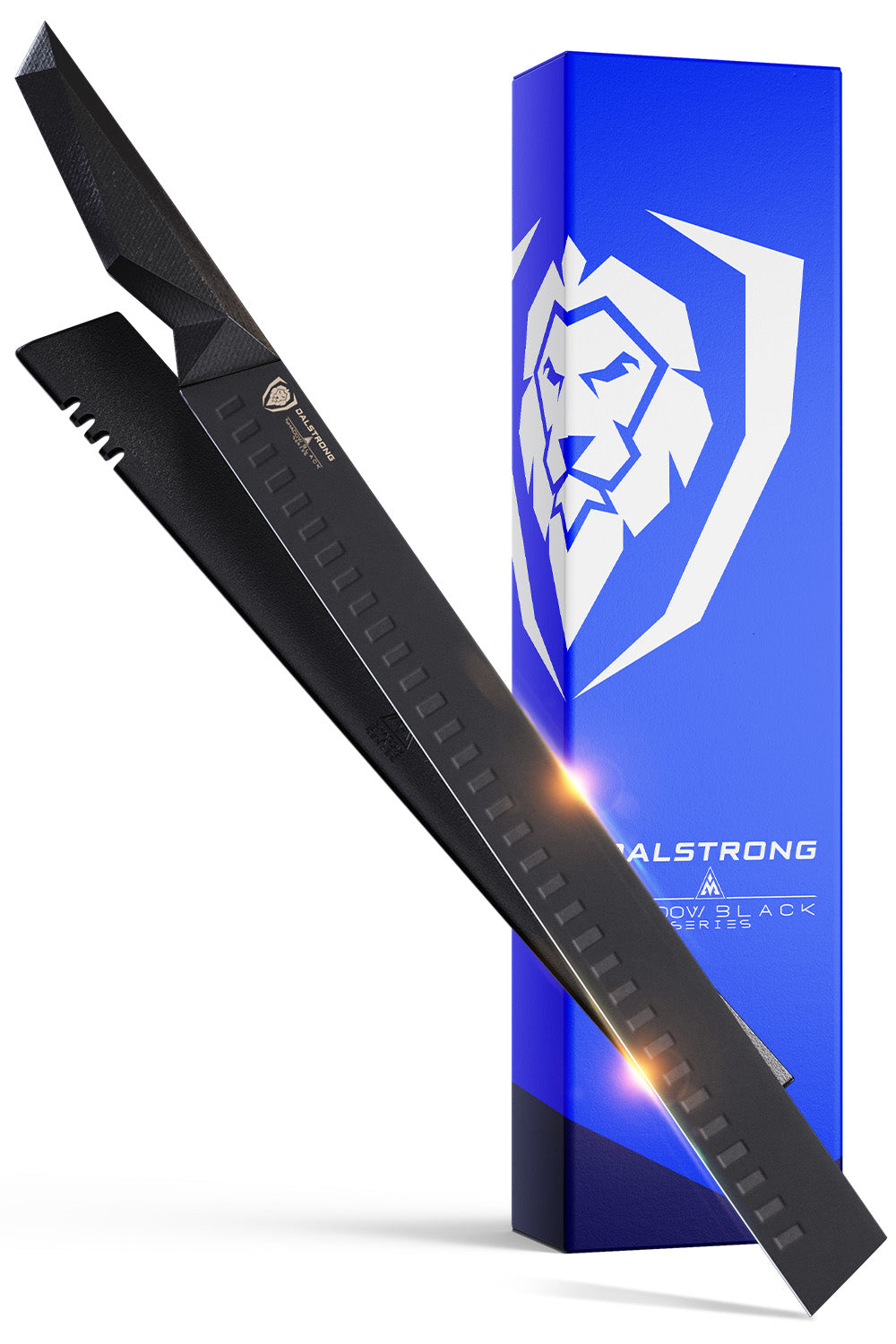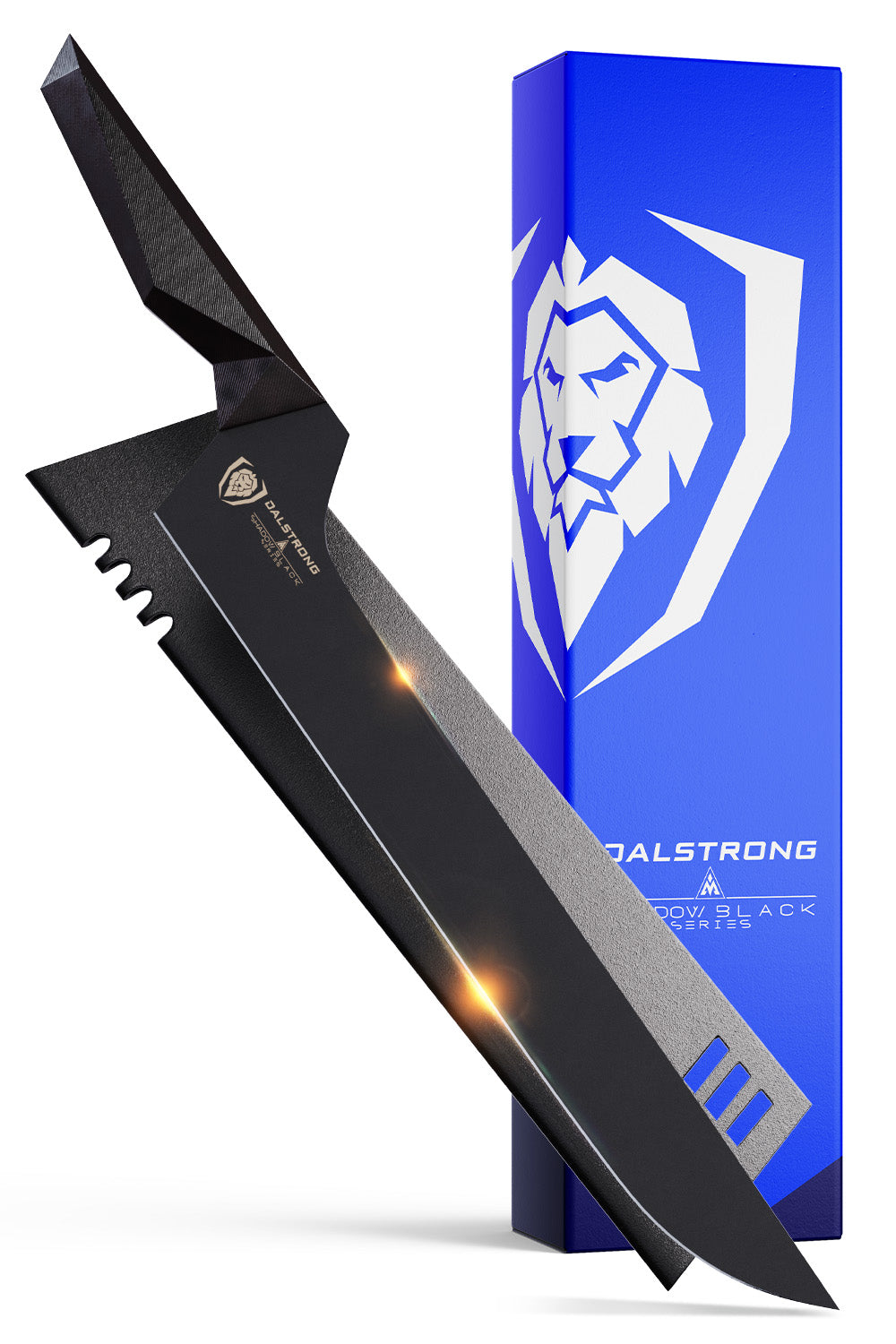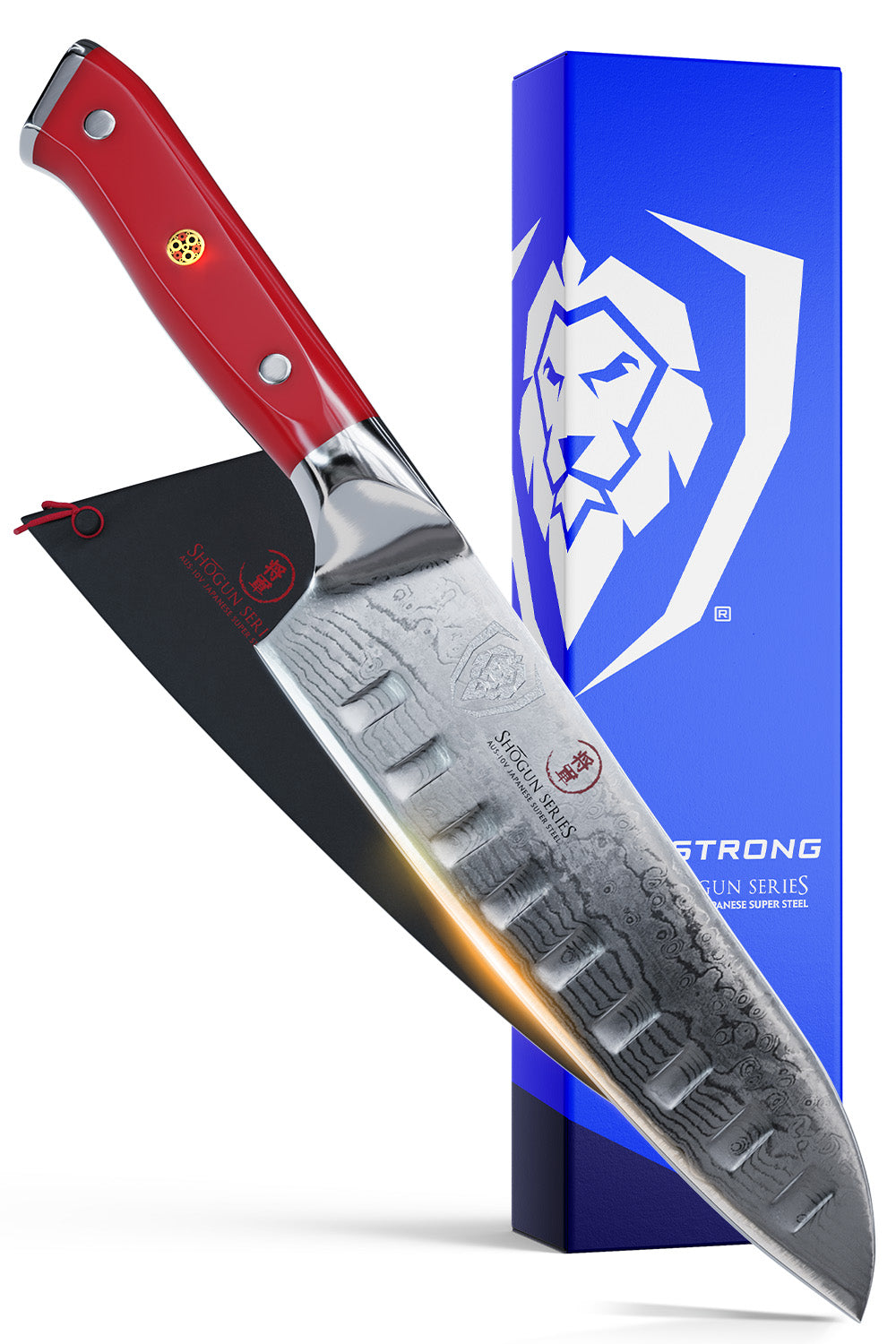
Imagine this: an all-around tool that has been an important partner to humans for thousands of years, transcending culture and time. Its gleaming, slender blade cuts through history, leaving behind a line of ingenuity, craftsmanship, and culinary proficiency. Yes, we're talking about the ageless image of the kitchen- the knife. From the well-built handle that offers control and comfort to the blade that sways with precision, let's embark on an enchanting ride through the fascinating parts of a knife, revealing the secrets of its functionality, design, and the stories it whispers with every slice.
1. What Are The Different Parts Of A Knife
 Chef's Knife 8" Spartan Ghost Series | Dalstrong ©
Chef's Knife 8" Spartan Ghost Series | Dalstrong ©
A typical knife consists of several basic parts. Here are the main components:
Blade
The blade is the slicing edge of the knife. It is typically made of steel and comes in various shapes, such as straight, serrated, or a combination of both. The blade's shape and edge type determine its functionality and purpose.
Point
The point refers to the tip of the blade. It can vary in shape, including a sharp, fine point or a more rounded, blunt point. Different point designs are suitable for specific tasks, such as piercing, slicing, or delicate work.
Edge
The edge is the sharpened side of the blade that makes contact with the object being cut. It is typically ground to form a bevel, creating a sharp cutting edge. Some knives have a straight edge, while others may have a serrated or scalloped edge for specific cutting purposes.
Spine
The spine is the upper, unsharpened edge of the blade opposite the cutting edge. It provides thickness and rigidity to the knife and is used for tasks that require applying pressure or force, such as splitting or crushing.
Tang
The tang names to the part of the blade that extends into the handle. It provides structural support and stability to the knife. A full tang extends the entire length of the handle, while a partial tang may extend only partially.
Handle
The handle is the part of the knife that you grip. It can be made from various materials, such as wood, plastic, metal, or composite materials. The handle should provide a comfortable and secure grip, allowing for precise control during use.
Bolster
The bolster is a thick junction between the blade and the handle, usually found in traditional knives. It adds mass and stability to the knife, improves stability, and helps protect the hand from accidentally slipping onto the blade.
Guard
Some knives may have a guard between the blade and the handle. The guard is a barrier designed to prevent your hand from sliding onto the blade during use, providing additional safety.
Butt
The butt is the rear end of the handle. It is often solid and can be used for tasks that require striking or pounding, such as tenderizing meat or cracking shells.
These are the basic parts of a knife, though the specific design and features can vary depending on the type of knife, its intended use, and the manufacturer.
2. Essential Kitchen Knives
 18-piece Colossal Knife Block Set
18-piece Colossal Knife Block Set
In a well-equipped kitchen, there are few vital knives that serve different purposes and cover a wide range of slicing tasks. Here are some of the most often used essential kitchen knives:
Chef's Knife
A flexible, all-purpose knife with a wide, curved blade ranging from 6 to 10 inches in length. It is used for dicing, slicing, mincing, and chopping a variation of ingredients, including fruits, meats, vegetables, and herbs.
For more information about chef's knives, read more here.
Paring Knife
A small knife with a small, pointed blade normally around 3 to 4 inches long. It is perfect for intricate tasks like trimming, peeling, and precise cutting, such as creating garnishes or deveining shrimp.
Santoku Knife
A Japanese-style knife with a shorter, wider blade and a flat edge. It is well-suited for dicing, slicing, and chopping fish, vegetables, and boneless meats. The word "Santoku" translates to "three virtues," showing its versatility in handling fish, meat, and vegetables.
Bread Knife
A serrated knife with a long, scalloped blade, normally around 8 to 10 inches in length. It is designed to cut through bread and other baked goods with least pressure, maintaining the delicate interior without crushing it.
Utility Knife
A mid-sized knife with a straight or slightly serrated edge, typically around 4 to 6 inches long. It is handy for various small to medium-sized slicing tasks that are too complex for a chef's knife but don't need the accuracy of a paring knife.
Carving Knife
A long, thin knife with a small blade, usually around 8 to 12 inches in length. It is specially designed for slicing cooked meats, such as hams, roasts, or poultry, into thin, balance slices.
These are the key kitchen knives that cover most slicing requirements in a home kitchen. Even so, depending on your particular cooking preferences and style, you may also think about adding other functional knives like a cleaver, boning knife, or fillet knife to your collection.
3. How To Maintain And Care For Your Knives
Proper maintenance and care are essential to keep your knives in optimal condition and extend their lifespan. Here are some tips on how to maintain and care for your knives:
Handwashing
Always wash your knives by hand rather than putting them in the dishwasher. Dishwashers can cause the blades to bang against other utensils, leading to dullness or even chipping. Use mild dish soap, warm water, and a non-abrasive sponge or cloth to clean the blades thoroughly.
Drying
After washing, dry your knives immediately and thoroughly to prevent moisture buildup. Moisture can cause rust and damage the blade. Utilize a soft, porous cloth to dry the knife completely, including the handle and the area where the blade meets the handle.
Storage
Store your knives in a safe and organized manner to avoid damage and ensure safety. Consider using a knife block, a knife magnet strip, a knife drawer insert, or blade guards to protect the blades from banging against other utensils or surfaces. Avoid storing knives loosely in a drawer where they can be damaged or cause accidents.
Cutting Surfaces
Be mindful of the cutting surfaces you use with your knives. Avoid cutting on hard surfaces like glass, granite, or ceramic plates, as they can dull or chip the blade. Instead, use cutting boards made of wood, bamboo, or soft plastic, which are gentler on the knife's edge.
Cutting Technique
Use proper cutting techniques to avoid unnecessary stress on the blade. Avoid twisting or prying with the knife, as it can damage the edge. Instead, use a slicing or rocking motion when cutting and let the sharpness of the blade do the work.
Honing
Regularly use a honing steel or honing rod to maintain the sharpness of the blade. Honing readjust the tiny teeth on the edge of the blade, keeping it sharp. Hold the honing steel vertically and gently slide the knife's blade against it at a 15 to 20-degree angle, starting from the base to the tip, on both sides of the blade.
Sharpening
Periodically sharpen your knives to restore their cutting edge. Depending on usage, knives typically require sharpening every few months or as needed. You can use a sharpening stone, a manual knife sharpener, or have them professionally sharpened. Follow the manufacturer's instructions or seek guidance to ensure proper sharpening technique.
Proper Usage
Use each knife for its intended purpose to prevent unnecessary strain and damage. For example, avoid using a chef's knife to pry open cans or bottles, as it can bend or chip the blade.
By following these maintenance and care practices, you can keep your knives in excellent condition, maintain their sharpness, and ensure safe and efficient cutting in the kitchen.
4. Recommended Dalstrong Knives
1. Chef Knife 10" Centurion Series Dalstrong
This is an impressive chef’s knife particularly for those who prefer bigger blades. Not only does it have the ease and versatility of use of a quality chef’s knife, but its extra length makes it particularly suited for cutting large meats as well. This is an attractive and powerful 10-inch chef’s knife from Dalstrong’s Centurion series, and it serves as a complete kitchen powerhouse.
PROS:
- With its special dimensions, you’ll be able to effortlessly slice, chop, or dice your food as well as slice thick strips of meat.
- super easy to clean and stain resistant.
- With an heavy-duty G10 handle.
CONS:
- This 10-inch knife can be a little massive for some people.
- This knife is definitely a little more costly than some people might want to spend.
2. Paring Knife 3.5" Gladiator Series NSF Certified Dalstrong
This amazing paring knife is a little larger. At 3.5”, this tool is still a remarkable paring knife that can be used for mincing, coring, and peeling vegetables and fruits. You can also use it to slice garlic, shallots, herbs, and more. And it also comes in useful for baking, as you can use it to cut designs and patterns onto your dough. A great small tool that will come in useful.
PROS:
- Simple to hold and pleasant to use thanks to its superbly engineered bolster and balance, which provides finger protection and counterweight.
- An stylish, understated look that is certain to go well with the rest of your kitchen look.
- Its dimensions make it an exceptional paring knife that can be used for exact cuts and beyond.
CONS:
- Common paring knives are a little smaller than this.
- This 3.5” paring knife is a bit heavier than you’re used to.
3. Santoku 7" Phantom Series Dalstrong
This is an ideal example of a Santoku knife, displaying all the standards that make it the go-to knife of possibility for many professional chefs and home cooks. It serves just about as the midway point between a cleaver and a chef’s knife. With its wider blade and straight edge, you’ll be able to transfer food and make a push slice, and its slightly curved blade makes for a comfortable rocking motion.
PROS:
- Features a conventional Japanese D-shaped handle crafted of black pakkawood.
- The blade is crafted from Japanese AUS-8 steel, engraved with the logo of Dalstrong and the Japanese kanji for “ghost”.
- Attentively hand-sharpened with Dalstrong's Diamond Detailing (D3) technique, bringing the blade to a razor-sharp.
CONS:
- For Japanese style knives, this Santoku is a little weighty than the regular ones.
- Some people prefer the G10 garolite handles over the pakkawood as a matter of personal taste.
4. Carving Knife & Fork Set 9" Crusader Series NSF Certified Dalstrong
At times you need more than a slicer to get the ideal cut. Gratefully, this stunning 9” carving knife comes with its own fork, granting you to get the ideal angle on those cuts you’re carving. As part of Dalstrong’s unpatterned Crusader series, these steel knives have a less approach to their visual display without sacrificing any of their performance or their style.
PROS:
- The blades are crafted of wear-resistant, ultra-sharp, high carbon ThyssenKrupp German stainless steel.
- The knife is attractively hand polished to a satin finish.
- Easy to clean and very hygienic, as they’re a single piece of steel with consistent transitions. That indicates there’s almost no place for waste to hide.
CONS:
- Since the knives in the Crusader series are hollow, this knife is a little lighter to handle than what some people might be looking forward to.
- Not everybody is a fan of the unpatterned beauty of the Crusader series.
5. Bread Knife 9" Shadow Black Series NSF Certified Dalstrong
This knife is one of the most awesome looking tools in the kitchen, but also because it's one of the best-crafted and highest quality knife on the market. This unbelievable 9 inch bread knife is an amazing example of that; slice through any loaf, no matter how crumbly with total ease.
PROS:
- Slice through bread, melons, cakes, and just about everything you need that’s tough and large to bite into.
- Its black, non-reflective titanium nitride coat and special design make it one of the most visually fascinating knives you’ll find.
- The appropriate handle fits snugly into your hand and makes working with this knife a total joy.
CONS:
- The titanium nitride coat and the serrations makes sharpening a little bit of a challenge.
- The special look of the Shadow Black series may not please everyone, mainly if you want all your kitchen tools to match.
5. Frequently Added Questions
What are the different parts of a knife called?
A knife consists of several different parts, each with its own name. Here are the main parts of a knife namely the blade, point, edge, spine, tang, handle, bolster, finger guard, heel, and butt.
What are the 4 parts of a chef's knife?
A chef's knife typically consists of four main parts. Called blade, edge, spine, and tang.
What are the 5 most common knives used in cooking?
The five most common knives used in cooking are: chef knife, paring knife, serrated bread knife, utility knife, and santoku knife.















